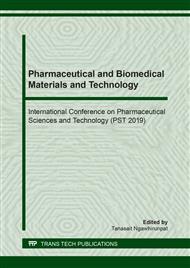[1]
H. Masaki, Role of antioxidants in the skin: anti-aging effects, J. Dermatol. Sci. 58 (2010) 85-90.
Google Scholar
[2]
A. Ryu, K. Arakane, C. Koide, H. Arai, T. Nagano, Squalene as a target molecule in skin hyperpigmentation caused by singlet oxygen, Biol. Pharm. Bull. 32 (2009), 1504-1509.
DOI: 10.1248/bpb.32.1504
Google Scholar
[3]
Y. Shindo, E. Witt, D. Han, W. Epstein, L. Packer, Enzymic and non-enzymic antioxidants in epidermis and dermis of human skin, J. Invest. Dermatol. 102 (1994), 122-124.
DOI: 10.1111/1523-1747.ep12371744
Google Scholar
[4]
M. Yamada, M.U. Udono, M. Hori, R. Hirose, S. Sato, T. Mori, O. Nikaido, Aged human skin removes UVB-induced pyrimidine dimers from the epidermis more slowly than younger adult skin in vivo, Arch. Dermatol. Res. 297 (2006), 294-302.
DOI: 10.1007/s00403-005-0618-0
Google Scholar
[5]
J.C. Barreto, M.T.S. Trevisan, W.E. Hull, G. Erben, E.S. De Brito, B. Pfundstein, G. Würtele, B. Spiegelhalder, R.W. Owen, Characterization and quantitation of polyphenolic compounds in bark kernel, leaves, and peel of mango (Mangifera indica L.), J. Agric. Food Chem. 56 (2008) 5599-5610.
DOI: 10.1021/jf800738r
Google Scholar
[6]
A. Jutiviboonsuk, C. Sardsaengjun, Mangiferin in leaves of three Thai mango (Mangifera indica L.), IJPS. 6 (2010) 122-129.
Google Scholar
[7]
A. Dar, S. Faizi, S. Naqvi, T. Roome, S. Zikr-ur-Rehman, M. Ali, S. Firdous, S.T. Moin, Analgesic and antioxidant activity of mangiferin and its derivatives: the structure activity relationship, Biol. Pharm. Bull. 28 (2005), 596-600.
DOI: 10.1248/bpb.28.596
Google Scholar
[8]
J. Rodrίguez, D.D. Pierro, M. Gioia, S. Monaco, R. Delgado, M. Coletta, S. Marini, Effects of a natural extract from Mangifera indica L, and its active compound, mangiferin, on energy state and lipid peroxidation of red blood cells, Biochim. Biophys. Acta. 1760 (2006), 1333-1342.
DOI: 10.1016/j.bbagen.2006.04.005
Google Scholar
[9]
S. Muruganandan, J. Lal, P.K. Gupta, Immunotherapeutic effects of mangiferin mediated by the inhibition of oxidative stress to activated lymphocytes, neutrophils and macrophages, Toxicology. 215 (2005), 57-68.
DOI: 10.1016/j.tox.2005.06.008
Google Scholar
[10]
J.J. Jeong, S.E. Jang, S.R. Hyam, M.J. Han, D.H. Kim, Mangiferin ameliorates colitis by inhibiting IRAK1 phosphorylation in NF-kB and MAPK pathways, Eur. J. Pharmacol. 740 (2014), 652-661.
DOI: 10.1016/j.ejphar.2014.06.013
Google Scholar
[11]
C.W. Pan, Z.Z. Pan, J.J. Hu, W.L. Chen, G.Y. Zhou, W. Lin, L.X. Jin, C.L. Xu, Mangiferin alleviates lipopolysaccharide and D-galactosamine-induced acute liver injury by activating the Nrf2 pathway and inhibiting NLRP3 inflammasome activation, Eur. J. Pharmacol. 770 (2016), 85-91.
DOI: 10.1016/j.ejphar.2015.12.006
Google Scholar
[12]
X. Gong, L. Zhang, R. Jiang, M. Ye, X. Yin, J. Wan, Anti-inflammatory effects of mangiferin on sepsis-induced lung injury in mice via up-regulation of heme oxygenase-1, J. Nutr. Biochem. 24 (2013), 1173-1181.
DOI: 10.1016/j.jnutbio.2012.09.003
Google Scholar
[13]
F. Gold-Smith, A. Fernandez, K. Bishop, Mangiferin and cancer: mechanisms of action, Nutrients. 8, 396 (2016).
DOI: 10.3390/nu8070396
Google Scholar
[14]
S. Chae, M.J. Piao, K.A. Kang, R. Zhang, K.C. Kim, U.J. Youn, K.W. Nam, J.H. Lee, J.W. Hyun, Inhibition of matrix metalloproteinase-1 induced by oxidative stress in human keratinocytes by mangiferin isolated from Anemarrhena asphodeloides, Biosci. Biotechnol. Biochem. 75 (2011), 2321-2325.
DOI: 10.1271/bbb.110465
Google Scholar
[15]
R. Ochocka, A. Hering, J. Stefanowicz-Hajduk, K. Cal, H. Barańska, The effect of mangiferin on skin: penetration, permeation and inhibition of ECM enzymes, PLoS ONE. 12, e0181542 (2017).
DOI: 10.1371/journal.pone.0181542
Google Scholar
[16]
Y. Prado, N. Merino, J. Acosta, JA. Herrera, Y. Luque, I. Hernández, E. Prado, G. Garrido, R. Delgado, I. Rodeiro, Acute and 28-day subchronic toxicity studies of mangiferin, a glucosyl xanthone isolated from Mangifera indica L. stem bark, J. Pharm. Pharmacogn. Res. 3 (2015), 13-23.
DOI: 10.1002/ptr.5177
Google Scholar
[17]
W. Leeprechanon, A. Jutiviboonsuk, Quantitative determination of mangiferin isolated from leaves of Mangifera indica L. variety Nam Doc Mai using HPTLC and its DPPH scavenging activity, Proceedings of the 6th international conference of Suan Sunandha Rajabhat University. 2015 Apr 28-29; Bangkok, Thailand (2015).
DOI: 10.7763/ijiet.2015.v5.587
Google Scholar
[18]
E. Chielie, N. Romiti, G. Garrido, In vitro effects of Mangifera indica and polyphenols derived on ABCB1/P-glycoprotein activity, Food Chem. Toxicol. 47 (2009), 2703-2710.
DOI: 10.1016/j.fct.2009.07.017
Google Scholar
[19]
MF. Hsu, CN Lin, MC Lu, JP Wang, Inhibition of the arachinodic acid cascade by norathyriol via blockade of cyclooxygenase and lipoxygenase activity in neutrophils, Naunyn Schmiedebergs Arch Pharmacol. 369 (2004), 507-515.
DOI: 10.1007/s00210-004-0922-9
Google Scholar
[20]
J. Li, M. Malakhova, M. Mottamal, K. Reddy, I. Kurinov, A. Carper, A. Langfald, N. Oi, MO. Kim, F. Zhu, CP. Sosa, K. Zhou, A.M. Bode, Z. Dong, Norathyriol suppresses solar UV-induced skin cáncer by targeting ERKs, Cancer Res. 72 (2012), 260-270.
DOI: 10.1158/0008-5472.can-11-2596
Google Scholar
[21]
C. Jo, KY. Yoon, EJ. Jang, TH. Kim, Degradation products of mangiferin by gamma irradiation with inhibitory effects on NO production, Biosci. Biotechnol. Biochem. 80 (2016), 2022-2024.
DOI: 10.1080/09168451.2016.1191335
Google Scholar


